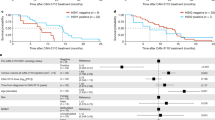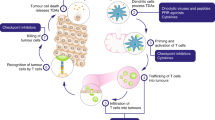Abstract
We evaluated the safety, efficacy and anti-tumor effects of a surgery adjuvant treatment on canine patients with malignant melanoma. This approach combined suicide gene therapy with a subcutaneous vaccine composed by formolized tumor cells and irradiated xenogeneic cells producing human interleukin-2 and granulocyte–macrophage colony-stimulating factor. The post-surgical margin of the cavity was infiltrated with lipid-complexed thymidine kinase suicide gene coadministrated with ganciclovir. Toxicity was minimal or absent in all patients. With respect to surgery-treated controls (SC), this combined treatment (CT) significantly increased the fraction of patients local disease-free from 6 to 58% and distant metastases-free from 43 to 78% (Fisher's Exact test). In addition, CT significantly improved both SC overall 78 (23–540) and metastasis-free survival 112 (0–467) days to more than 1312 days (respective ranges: 43–1312 and 0–1312) (Kaplan–Meier analysis). In those patients subjected to partial surgery or presenting local recurrence, the efficacy of CT was verified by a 49% of objective responses that averaged 85% of tumor mass loss, while 22% displayed tumor progression as 94% of SC did. Therefore, surgery adjuvant CT controlled tumor growth, delaying or preventing post-surgical recurrence and distant metastasis, significantly extending survival and recovering the quality of life.
This is a preview of subscription content, access via your institution
Access options
Subscribe to this journal
Receive 12 print issues and online access
$259.00 per year
only $21.58 per issue
Buy this article
- Purchase on Springer Link
- Instant access to full article PDF
Prices may be subject to local taxes which are calculated during checkout




Similar content being viewed by others
References
Hansen K, Khanna C . Spontaneous and genetically engineered animal models; use in preclinical cancer drug development. Eur J Cancer 2004; 40: 858–880.
Modiano JF, Breen M, Lana SL, Ehrhart N, Fosmire SP, Thomas R et al. Naturally occurring translational models for development of cancer gene therapy. Gene Ther Mol Biol 2006; 10: 31–40.
Ramos-Vara JA, Beissenherz ME, Miller MA, Johnson GC, Pace LW, Fard A et al. Retrospective study of 338 canine oral melanomas with clinical, histologic, and immunohistochemical review of 129 cases. Vet Pathol 2000; 37: 597–608.
Smith SH, Goldschmidt MH, McManus PM . A comparative review of melanocytic neoplasms. Vet Pathol 2002; 39: 651–678.
Quintin-Colonna F, Devauchelle P, Fradelizi D, Mourot B, Faure T, Kourilsky P et al. Gene therapy of spontaneous canine melanoma and feline fibrosarcoma by intratumoral administration of histoincompatible cells expressing human interleukin-2. Gene Therapy 1996; 3: 1104–1112.
Hogge GS, Burkholder JK, Culp J, Albertini MR, Dubielzig RR, Keller ET et al. Development of human granulocyte-macrophage colony-stimulating factor-transfected tumor cell vaccines for the treatment of spontaneous canine cancer. Hum Gene Ther 1998; 9: 1851–1861.
Dow SW, Elmslie RE, Willson AP, Roche L, Gorman C, Potter TA . In vivo tumor transfection with superantigen plus cytokine genes induces tumor regression and prolongs survival in dogs with malignant melanoma. J Clin Invest 1998; 101: 2406–2414.
Bergman PJ, McKnight J, Novosad A, Charney S, Farrelly J, Craft D et al. Long-term survival of dogs with advanced malignant melanoma after DNA vaccination with xenogeneic human tyrosinase: a phase I trial. Clin Cancer Res 2003; 9: 1284–1290.
Bianco SR, Sun J, Fosmire SP, Hance K, Padilla ML, Ritt MG et al. Enhancing antimelanoma immune responses through apoptosis. Cancer Gene Ther 2003; 10: 726–736.
Alexander AN, Huelsmeyer MK, Mitzey A, Dubielzig RR, Kurzman ID, Macewen EG et al. Development of an allogeneic whole-cell tumor vaccine expressing xenogeneic gp100 and its implementation in a phase II clinical trial in canine patients with malignant melanoma. Cancer Immunol Immunother 2006; 55: 433–442.
Wolchok JD, Livingston PO . Vaccines for melanoma: translating basic immunology into new therapies. Lancet Oncol 2001; 2: 205–211.
Greten TF, Jaffee EM . Cancer vaccines. J Clin Oncol 1999; 17: 1047–1060.
Fernandez N, Duffour MT, Perricaudet M, Lotze MT, Tursz T, Zitvogel L . Active specific T-cell-based immunotherapy for cancer: nucleic acids, peptides, whole native proteins, recombinant viruses, with dendritic cell adjuvants or whole tumor cell-based vaccines. Principles and future prospects. Cytokines Cell Mol Ther 1998; 4: 53–65.
Finocchiaro LME, Fiszman GL, Karara AL, Glikin GC . Suicide gene and cytokines combined non viral gene therapy for spontaneous canine melanoma. Cancer Gene Ther 2007; 14 (in press).
Touraine RL, Vahanian N, Ramsey WJ, Blaese RM . Enhancement of the herpes simplex virus thymidine kinase/ganciclovir bystander effect and its antitumor efficacy in vivo by pharmacologic manipulation of gap junctions. Hum Gene Ther 1998; 9: 2385–2391.
Mesnil M, Yamasaki H . Bystander Effect in Herpes Simplex Virus-Thymidine Kinase/Ganciclovir Cancer Gene Therapy: Role of Gap-junctional Intercellular Communication. Cancer Res 2000; 60: 3989–3999.
Carrio M, Mazo A, Lopez- Iglesias C, Estivill X, Fillat C . Retrovirus – mediated transfer of the herpes simplex virus thymidine kinase and connexin26 genes in pancreatic cells results in variable efficiency on the bystander killing: implications for gene therapy. Int J Cancer 2001; 94: 81–88.
Ramesh R, Munshi A, Abboud CN, Marrogi AJ, Freeman SM . Expression of costimulatory molecules: B7 and ICAM up-regulation after treatment with a suicide gene. Cancer Gene Ther 1996; 3: 373–384.
Li XL, Boyanapalli M, Weihua X, Kalvakolanu DV, Hassel BA . Induction of interferon synthesis and activation of interferon-stimulated genes by liposomal transfection reagents. J Interferon Cytokine Res 1998; 18: 947–952.
Chu RS, Targoni OS, Krieg AM, Lehmann PV, Harding CV . CpG oligodeoxynucleotides act as adjuvants that switch on T helper 1 (Th1) immunity. J Exp Med 1997; 186: 1623–1631.
Roman M, Martin-Orozco E, Goodman JS, Nguyen MD, Sato Y, Ronaghy A et al. Immunostimulatory DNA sequences function as T helper-1-promoting adjuvants. Nat Med 1997; 3: 849–854.
Rochlitz C, Dreno B, Jantscheff P, Cavalli F, Squiban P, Acres B et al. Immunotherapy of metastatic melanoma by intratumoral injections of Vero cells producing human IL-2: phase II randomized study comparing two dose levels. Cancer Gene Ther 2002; 9: 289–295.
Rosenberg SA . Progress in human tumour immunology and immunotherapy. Nature 2001; 411: 380–384.
Dranoff G . GM-CSF-based cancer vaccines. Immunol Rev 2002; 188: 147–154.
Soiffer R, Lynch T, Mihm M, Jung K, Rhuda C, Schmollinger JC et al. Vaccination with irradiated autologous melanoma cells engineered to secrete human granulocyte-macrophage colony-stimulating factor generates potent antitumor immunity in patients with metastatic melanoma. Proc Natl Acad Sci USA 1998; 95: 13141–13146.
Pan PY, Li Y, Li Q, Gu P, Martinet O, Thung S et al. In situ recruitment of antigen-presenting cells by intra-tumoral GM-CSF gene delivery. Cancer Immunol Immunother 2004; 53: 17–25.
Proulx DR, Ruslander DM, Dodge RK, Hauck ML, Williams LE, Horn B et al. A retrospective analysis of 140 dogs with oral melanoma treated with external beam radiation. Vet Radiol Ultrasound 2003; 44: 352–359.
Rassnick KM, Ruslander DM, Cotter SM, Al-Sarraf R, Bruyette DS, Gamblin RM et al. Use of carboplatin for treatment of dogs with malignant melanoma: 27 cases (1989–2000). J Am Vet Med Assoc 2001; 218: 1444–1448.
Freeman KP, Hahn KA, Harris FD, King GK . Treatment of dogs with oral melanoma by hypofractionated radiation therapy and platinum-based chemotherapy (1987–1997). J Vet Intern Med 2003; 17: 96–101.
Kaufman RJ, Davies MV, Wasley LC, Michnick D . Improved vectors for stable expression of foreign genes in mammalian cells by use of the untranslated leader sequence from EMC virus. Nucleic Acids Res 1991; 19: 4485–4490.
Casais CC, Karara AL, Glikin GC, Finocchiaro LME . Effects of spatial configuration on tumor cells transgene expression. Gene Ther Mol Biol 2006; 10: 207–222.
Finocchiaro LME, Bumaschny VF, Karara AL, Fiszman GL, Casais CC, Glikin GC . Herpes simplex virus thymidine kinase/ganciclovir system in multicellular tumor spheroids. Cancer Gene Ther 2004; 11: 333–345.
San H, Yang ZY, Pompili VJ, Jaffe ML, Plautz GE, Xu L et al. Safety and short-term toxicity of a novel cationic lipid formulation for human gene therapy. Hum Gene Ther 1993; 4: 781–788.
Gao X, Huang L . Cationic liposome-mediated gene transfer. Gene Therapy 1995; 2: 710–722.
Acknowledgements
We are grateful to our patients and their owners for their cooperation and participation in this study. We thank Dr Armando L Karara for psCMVtk, Dr Gabriel L Fiszman for cytokine-producing cells, María D Riveros for vaccine preparation, Marie Maminska for patients’ treatment and care and the Centro de Especialidades Médicas Veterinarias (CEMV, Buenos Aires) for kindly lending its facilities for patients’ treatment. This work was supported by a Grant from FONCYT: BID1728/OC-AR—PID 2000—00161, and a grant from BioSidus SA (Argentina). LMEF and GCG are members of the Consejo Nacional de Investigaciones Científicas y Técnicas (CONICET, Argentina).
Author information
Authors and Affiliations
Corresponding author
Rights and permissions
About this article
Cite this article
Finocchiaro, L., Glikin, G. Cytokine-enhanced vaccine and suicide gene therapy as surgery adjuvant treatments for spontaneous canine melanoma. Gene Ther 15, 267–276 (2008). https://doi.org/10.1038/sj.gt.3303072
Received:
Revised:
Accepted:
Published:
Issue Date:
DOI: https://doi.org/10.1038/sj.gt.3303072
Keywords
This article is cited by
-
Combination of cytokine-enhanced vaccine and chemo-gene therapy as surgery adjuvant treatments for spontaneous canine melanoma
Gene Therapy (2019)
-
Interferon-β lipofection II. Mechanisms involved in cell death and bystander effect induced by cationic lipid-mediated interferon-β gene transfer to human tumor cells
Cancer Gene Therapy (2012)
-
Interferon-β lipofection I. Increased efficacy of chemotherapeutic drugs on human tumor cells derived monolayers and spheroids
Cancer Gene Therapy (2012)
-
Cytokine-enhanced vaccine and suicide gene therapy as surgery adjuvant treatments for spontaneous canine melanoma: 9 years of follow-up
Cancer Gene Therapy (2012)
-
Suicide gene therapy on spontaneous canine melanoma: correlations between in vivo tumors and their derived multicell spheroids in vitro
Gene Therapy (2010)



